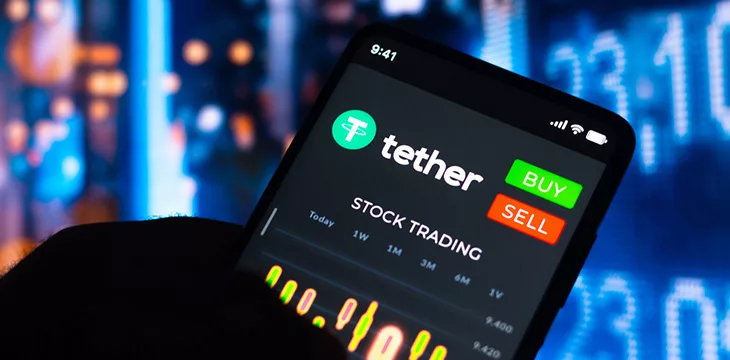|
Getting your Trinity Audio player ready...
|
Tether is aggressively buying BTC with its alleged ‘profits’ because, well, somebody has to stop the token’s falling value.
On Wednesday, Tether announced that, starting this month, it would “regularly allocate up to 15% of its net realized operating profits towards purchasing” BTC. The company behind the largest stablecoin by market cap said this strategy “aims to capitalize on the digital asset’s potential growth” and reflects Tether’s “confidence in the cryptocurrency market and its belief in supporting the broader ecosystem.”
Last week, Tether admitted having already bought $1.5 billion worth of BTC, representing 1.83% of the fiscal reserves backing its now nearly $83 billion in issued USDT tokens. Conveniently enough, Tether reported a near-identical amount ($1.48 billion) of alleged ‘net profits’ in the first quarter of 2023. This is according to Tether’s latest attestation—which is not an official third-party audit, something Tether habitually refuses to undergo (despite years of promises).
To be clear, Tether has long bought BTC but it previously lumped these purchases into indistinct, catch-all categories like ‘other investments.’ Tether periodically revises its reserve asset categories, in part because it thwarts direct comparisons of assets that Tether insists can’t be independently verified without posing an existential threat to its business model.
Such switcheroos also allow Tether to eliminate certain categories if/when they become problematic, like commercial paper from dodgy Chinese real estate companies or ‘secured loans’ from unspecified parties that later go bankrupt, all somehow without the slightest impact on Tether’s bottom line.
Tether recently posted a fawning tribute to itself for having (allegedly) enjoyed a larger quarterly profit than Blackrock, Cash App, Netflix (NASDAQ: NFLX), Paypal (NASDAQ: PYPL) and Starbucks (NASDAQ: SBUX). Tether conveniently ignores that those corporations are required to undergo third-party audits, which (usually) makes it a lot harder to pass off shit as shinola.
Some digital sleuths claim to have identified the secret sauce in Tether’s accounting and declared it rancid. Others suspect that Tether has long used BTC as a mainstay of its reserves and is now orchestrating these sudden ‘profits’—which go utterly unmentioned in BDO Italia’s ‘tick this box’ attestation—as a means of slowly unveiling the true extent of its BTC stash so as not to roil the market.
But who’s to say? Nobody, because without certifiable data, Tether’s lengthy history of deception, fraud and other perfidious practices opens the door wide for such conjecture. Even assuming their new financial plan is on the up and up, the question becomes: why BTC?
Tether’s announcement of its new strategy quoted CTO Paolo Ardoino saying BTC “has continually proven its resilience and has emerged as a long-term store of value with substantial growth potential.” That statement utterly ignores the fiscal rollercoaster ride of the past 18 months, which would make BTC a fine fit for a Six Flags amusement park.
Our personal theory is that Tether understands all too well that BTC is in serious trouble, having failed to make good on any of its paradigm-shifting promises. Perception can be reality, and if something isn’t done soon to help this flightless bird take wing, BTC will follow the dodo into extinction.
BTC-19
Crypto, like nature, abhors a vacuum. BTC’s fiat value peaked in November 2021, seven months or so after the third and final round of federal government stimulus checks were sent to U.S. citizens. Intended to help citizens ride out the pandemic downturn, a good chunk of this federal aid was instead plowed into decidedly non-essential pursuits.
For instance, after the first round of checks was approved in March 2020, some 13.7% of recipients used these funds for ‘savings & investments.’ The December 2020 approval of the second round of checks boosted this ‘investment’ allocation to 15.4%, while the third round in the spring of 2021 pushed it higher still to 16.7%.
Drilling deeper, a 2021 poll found that 7% of Americans used at least part of their initial round of stimulus checks to buy digital assets. More than half (53%) of those who planned to invest their second round of checks intended to do so via digital currencies. A Mizhuo Securities survey found that the third round of checks could result in an extra $40 billion funneled into ‘investments,’ with crypto accounting for 60% of those billions.
Sadly, despite the expectations of many, there was to be no fourth round of federal freebies in late-2021. Lo and behold, BTC’s value maxed out that November and began its swift downward spiral shortly thereafter.
The ongoing lack of artificial stimulation can be found in today’s sharply diminished trading volume at digital asset exchanges. Neither institutional nor retail investors appear to have much enthusiasm left after a solid year of downgrades, rugpulls, insolvencies and fraud. What little activity is occurring is almost certainly driven by bot-based wash trading, a vain attempt to fool the masses into thinking there’s still life in this semi-reanimated corpse.
Six feet under
Tether’s plan to buy massive quantities of BTC mirrors that of MicroStrategy (NASDAQ: MSTR), which currently holds around 140,000 BTC tokens worth nearly $4 billion. MicroStrategy founder Michael Saylor—who has his own history of fraudulent activity both recent and historic—borrowed billions to buy his BTC, apparently convinced that the ‘free money’ party would never end.
Like MicroStrategy, Tether doesn’t seem to want to do anything with its BTC haul other than sit on it and wait for its fiat value to rise (or fall, like the 9% decline the token’s value has experienced over the past 30 days).
This popular view of BTC as speculative ‘digital gold’ reflects the token’s utter impracticality in fulfilling Bitcoin’s original purpose: a peer-to-peer electronic cash system. The artificial constraints imposed on the original Bitcoin protocol by the BTC Core developers ensured that the resulting technology (BTC) has little functionality other than as a chip to wager in the digital asset exchange casinos.
CoinGeek isn’t known for its overt religiosity, but given Paolo’s (presumably) a good Italian Catholic boy, we’re tempted to ask the fateful question: what would Jesus do? Well, consider His parable of the three servants, to whom their earthly master gave different amounts of cash with which to build greater wealth through whatever means they saw fit.
While two of these servants rose to the challenge, BTC backers are the servant who chose to dig a hole and bury his cash for safekeeping rather than put it to any practical purpose that might result in real value growth. The mantra of ‘1 BTC = 1 BTC’ attests to this limited worldview, in which one stands back and admires one’s inert assets rather than employ them in any use for which they were intended.
This seems as good a time as any to remind everyone that there’s a little shindig starting May 31 at the QEII Centre in London at which all sorts of people will be discussing all sorts of ways to use Bitcoin—the real Bitcoin—as its founder Satoshi Nakamoto intended. Trust us: after choking through the Tether-BTC smog, it’ll be a breath of fresh air.
Follow CoinGeek’s Crypto Crime Cartel series, which delves into the stream of groups—from BitMEX to Binance, Bitcoin.com, Blockstream, ShapeShift, Coinbase, Ripple,
Ethereum, FTX and Tether—who have co-opted the digital asset revolution and turned the industry into a minefield for naïve (and even experienced) players in the market.

 07-15-2025
07-15-2025 





